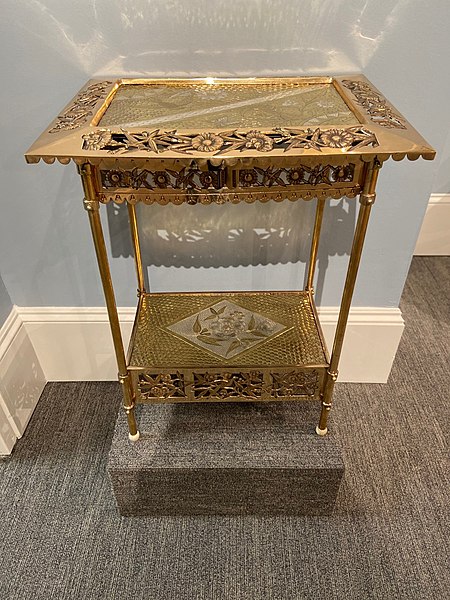Aestheticism was an art movement in the late 19th century that valued the appearance of literature, music, fonts and the arts over their functions. According to Aestheticism, art should be produced to be beautiful, rather than to teach a lesson, create a parallel, or perform another didactic purpose, a sentiment best illustrated by the slogan "art for art's sake." Aestheticism flourished in the 1870s and 1880s, gaining prominence and the support of notable writers such as Walter Pater and Oscar Wilde.
The Peacock Room, designed in the Anglo-Japanese style by James Abbott McNeill Whistler and Edward Godwin, one of the most famous and comprehensive examples of Aesthetic interior design
Canaries by Albert Joseph Moore, ca. 1875–1880. Moore was among a group of artists whose work was exhibited at the Grosvenor Gallery in London.
“Lady Lilith” by Dante Gabriel Rossetti
Aesthetic Brass Table by Bradley & Hubbard Company (see A Brass Menagerie, Metalwork of the Aesthetic Movement)
An art movement is a tendency or style in art with a specific art philosophy or goal, followed by a group of artists during a specific period of time, or, at least, with the heyday of the movement defined within a number of years. Art movements were especially important in modern art, when each consecutive movement was considered a new avant-garde movement. Western art had been, from the Renaissance up to the middle of the 19th century, underpinned by the logic of perspective and an attempt to reproduce an illusion of visible reality. By the end of the 19th century many artists felt a need to create a new style which would encompass the fundamental changes taking place in technology, science and philosophy.
Jacques-Louis David, The Coronation of Napoleon, (1806), Musée du Louvre, Neoclassicism
Eugène Delacroix, Liberty Leading the People 1830, Romanticism
Thomas Cole, The Course of Empire: The Savage State, 1836, Hudson River School
Gustave Courbet, Stone-Breakers, 1849, Realist School








